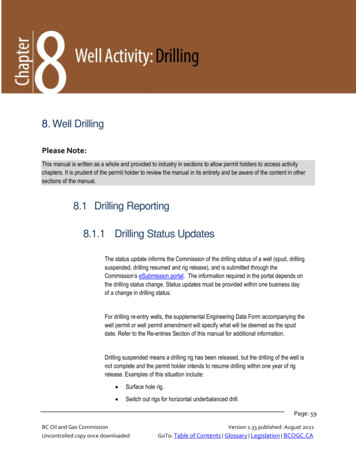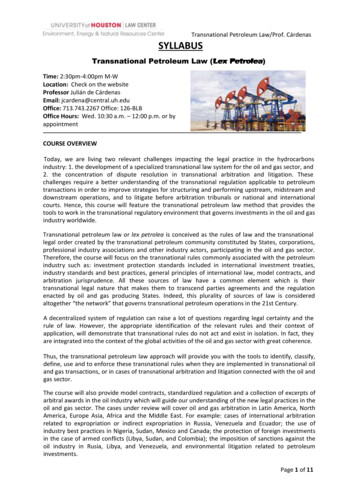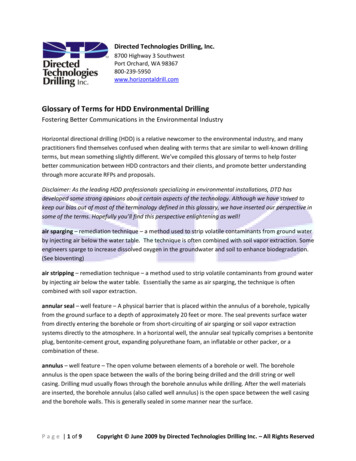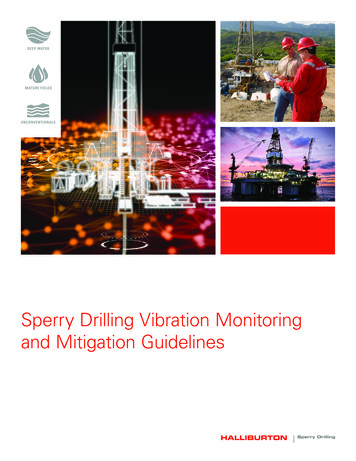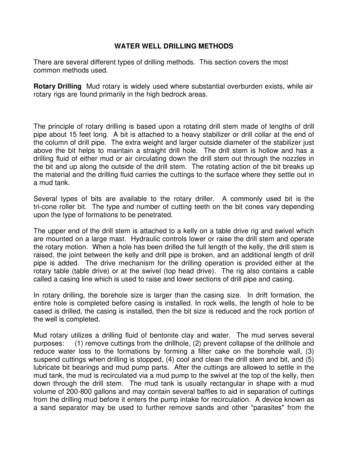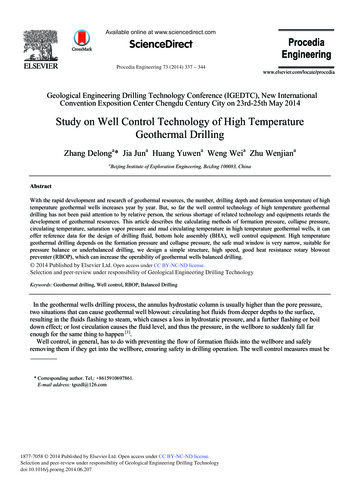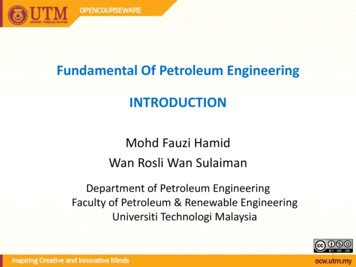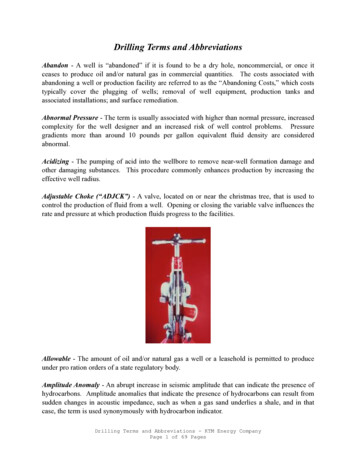
Transcription
Drilling Terms and AbbreviationsAbandon - A well is “abandoned” if it is found to be a dry hole, noncommercial, or once itceases to produce oil and/or natural gas in commercial quantities. The costs associated withabandoning a well or production facility are referred to as the “Abandoning Costs,” which coststypically cover the plugging of wells; removal of well equipment, production tanks andassociated installations; and surface remediation.Abnormal Pressure - The term is usually associated with higher than normal pressure, increasedcomplexity for the well designer and an increased risk of well control problems. Pressuregradients more than around 10 pounds per gallon equivalent fluid density are consideredabnormal.Acidizing - The pumping of acid into the wellbore to remove near-well formation damage andother damaging substances. This procedure commonly enhances production by increasing theeffective well radius.Adjustable Choke (“ADJCK”) - A valve, located on or near the christmas tree, that is used tocontrol the production of fluid from a well. Opening or closing the variable valve influences therate and pressure at which production fluids progress to the facilities.Allowable - The amount of oil and/or natural gas a well or a leasehold is permitted to produceunder pro ration orders of a state regulatory body.Amplitude Anomaly - An abrupt increase in seismic amplitude that can indicate the presence ofhydrocarbons. Amplitude anomalies that indicate the presence of hydrocarbons can result fromsudden changes in acoustic impedance, such as when a gas sand underlies a shale, and in thatcase, the term is used synonymously with hydrocarbon indicator.Drilling Terms and Abbreviations - KTM Energy CompanyPage 1 of 69 Pages
Annulus - The space between two concentric lengths of pipe or between pipe and the hole inwhich it is located.Anticlinal Trap - A type of structural hydrocarbon trap whose closure is controlled by thepresence of an anticline.Anticline - An arch-shaped fold in rock in which rock layers are upwardly convex. Anticlinesform many excellent hydrocarbon traps, particularly in folds with reservoir-quality rocks in theircore and impermeable seals in the outer layers of the fold. A syncline is the opposite type offold.Drilling Terms and Abbreviations - KTM Energy CompanyPage 2 of 69 Pages
API Gravity - A specific gravity scale developed by the American Petroleum Institute (API) formeasuring the relative density of various petroleum liquids, expressed in degrees. API gravity isgradated in degrees on a hydrometer instrument and was designed so that most values would fallbetween 10 and 70 API gravity.Associated Gas - Natural gas that is produced from the same reservoir along with crude oil,either as free gas or in solution.Authority for Expenditure (“AFE”) - A budgetary document to list estimated expenses ofdrilling a well to a specified depth, casing point or geological objective, and then eithercompleting or abandoning the well. Such expenses may include excavation and surface sitepreparation, the daily rental rate of a drilling rig, costs of fuel, drillpipe, bits, casing, cement andlogging, and coring and testing of the well, among others. This estimate of expenses is providedto partners for approval before commencement of drilling or subsequent operations. Failure toapprove an AFE may result in delay or cancellation of the proposed drilling project orsubsequent operation.Back Off (“BO”) - To unscrew drillstring components downhole. The drillstring, includingdrillpipe and the bottomhole assembly, are coupled by various thread forms known asconnections or tool joints. Often when a drillstring becomes stuck it is necessary to “back off”the string as deep as possible to recover as much of the drillstring as possible. To facilitate thefishing or recovery operation, the back off is usually accomplished by applying reverse torqueand detonating an explosive charge inside a selected threaded connection.Back-in - The right to receive a reversionary interest at some future time, upon fulfillment ofcontractually specified conditions. This clause allows a non participating partner to reserve theoption to participate in a well after it has produced enough to pay the operator’s expenses ofdrilling and completing that well. This clause is typically used in participation agreements toconvert the overriding royalty interest of a non participating partner (the Generator) into aworking interest upon payout of the well. When the election to convert the overriding royaltyinterest to working interest takes place, it is known as a “back-in after payout.”Bailer - A cylindrical, bucket-like piece of equipment used to evacuate its liquid content in, orremove mud and rock cuttings from, the hole or wellbore.Barrels of Condensate Per Day (“BCPD”) - A common unit of measurement for the dailyvolume of condensate produced by a well. The volume of a barrel is equivalent to 42 U.S.gallons.Barrels of Oil Per Day (“BOPD”) - A common unit of measurement for the daily volume ofcrude oil produced by a well. The volume of a barrel is equivalent to 42 U.S. gallons.Drilling Terms and Abbreviations - KTM Energy CompanyPage 3 of 69 Pages
Barrels of Water Per Day (“BWPD”) - A common unit of measurement for the daily volume ofwater produced by a well. The volume of a barrel is equivalent to 42 U.S. gallons.Basic Sediment and Water (“BS&W”) - A combination of impurities and water which is oftenproduced with crude oil. BS&W is heavier than oil and will settle to the bottom of a tank.Bit - The tool used to crush or cut rock. Everything on a drilling rig directly or indirectly assiststhe bit in crushing or cutting the rock.Blind Ram - A thick, heavy steel component of a conventional ram blowout preventer. The blindram has no space for pipe and is instead blanked off to be able to close over a well that does notcontain a drillstring. It may be loosely thought of as the sliding gate on a gate valve.Blowout - An uncontrolled flow of reservoir fluids into the borehole, and sometimescatastrophically to the surface. A blowout may consist of saltwater, oil, natural gas or a mixtureof these. Blowouts occur in all types of exploration and production operations, not just duringdrilling operations. (see “Underground Blowout”)Blowout Preventer (“BOP” or “BOPE”) - A large valve at the top of a well that may be closedif the drilling crew loses control of formation fluids. By closing this valve (usually operatedremotely by hydraulic actuators), the drilling crew usually regains control of the reservoir, andprocedures can then be initiated to increase the mud weight until it is possible to open the BOPand retain pressure control of the formation. A BOP comes in a variety of styles, sizes andpressure ratings. Since a BOP is critically important to the safety of the crew, the rig and thehole or wellbore itself, the BOP is inspected, tested and refurbished at regular intervals.Drilling Terms and Abbreviations - KTM Energy CompanyPage 4 of 69 Pages
Borehole - The hole itself, including the openhole or uncased portion of the well. Borehole mayrefer to the inside diameter of the hole wall, the rock face that bounds the drilled hole.Bottomhole Assembly (“BHA”) - The lower portion of the drillstring, consisting of (from thebottom up) the bit, bit sub, a mud motor (in certain cases), stabilizers, drill collars, heavyweightdrillpipe, jarring devices (“jar”) and crossovers for various thread forms. The bottomholeassembly can also include directional drilling and measuring equipment, measurements-whiledrilling tools, logging-while-drilling tools and other specialized devices.This space is intentionally left blank.Drilling Terms and Abbreviations - KTM Energy CompanyPage 5 of 69 Pages
Bottomhole Location (“BHL”) - The actual location of a hole or wellbore at its deepest point.Bottomhole Pressure (“BHP”) - The pressure at or near the depth of the producing formation.Bottoms-up - Pertaining to the drilling mud and cuttings that are calculated or measured to comefrom the bottom of the hole since the start of circulation.Break Circulation - To establish circulation of drilling fluids after a period of static conditions.Circulation may resume after a short break, such as taking a survey or making a mouseholeconnection, or after a prolonged interruption, such as after a round trip.Break Out - To unscrew drillstring components, which are coupled by various thread formsknown as connections, including tool joints and other threaded connections.Drilling Terms and Abbreviations - KTM Energy CompanyPage 6 of 69 Pages
Bridge - A wellbore obstruction caused by a buildup of material such as scale, wellbore fill orcuttings that can restrict borehole access or, in severe cases, eventually close the borehole.Bridge-off - The accumulation or buildup of material, such as sand or scale, within a wellbore,insofar as the flow of fluids or passage of tools or downhole equipment is severely obstructed. Inextreme cases, the wellbore can become completely plugged or bridged-off, requiring someremedial action before normal production can be resumed.Bridge Plug (“BP”) - A downhole tool that is located and set to isolate the lower part of thewellbore. Bridge plugs may be permanent or retrievable, enabling the lower wellbore to bepermanently sealed from production or temporarily isolated from a treatment conducted on anupper zone.Bright Spot - A seismic amplitude anomaly or high amplitude that can indicate the presence ofhydrocarbons. Bright spots result from large changes in acoustic impedance and tuning effects,such as when a gas sand underlies a shale, but can also be caused by phenomena other than thepresence of hydrocarbons, such as a change in lithology. The term is often used synonymouslywith hydrocarbon indicator.Bullhead - To forcibly pump fluids into a formation, usually formation fluids that have enteredthe wellbore during a well control event.Bump the Plug - To observe the increase in pump pressure indicating that the top cement plughas been placed on the bottom plug or landing collar. Bumping the plug concludes thecementing operation.Cap Rock - A relatively impermeable rock, commonly shale, anhydrite or salt, that forms abarrier or seal above and around reservoir rock so that fluids cannot migrate beyond thereservoir. It is often found on top of salt domes.Drilling Terms and Abbreviations - KTM Energy CompanyPage 7 of 69 Pages
Cap the Well - To regain control of a blowout well by installing and closing a valve on thewellhead.Carried Working Interest - A working interest generally paid in consideration for work related tothe prospect. This interest is paid, or carried, for the drilling and/or completion costs asspecified in the contract between the parties, by another working interest owner typically untilcasing point is reached, or through the tanks, meaning through completion of the well, as agreedupon contractually.Cased Hole - A wellbore lined with a string of casing or liner. Although the term can apply toany hole section, it is often used to describe techniques and practices applied after a casing orliner has been set across the reservoir zone, such as cased-hole logging or cased-hole testing.Casing (“Csg”) - In the case of drilling, a large-diameter pipe lowered into an openhole andcemented in place. Casing is run to protect freshwater formations (“surface casing”), isolate azone of lost returns or isolate formations with significantly different pressure gradients(“intermediate casing”). Casing is usually manufactured from plain carbon steel that is heattreated to varying strengths, but may be specially fabricated of stainless steel, aluminum,titanium, fiberglass and other materials. In the case of completion, a large-diameter pipecemented in place during the construction process to stabilize the wellbore. The casing forms amajor structural component of the wellbore and serves important functions, such as preventingthe formation wall from caving into the wellbore and isolating the different formations to preventthe flow or cross flow of formation fluids. The casing string provides a means of securingsurface pressure control equipment and downhole production equipment, such as the productionpacker. The operation of installing casing is commonly referred to as “running pipe” or “settingpipe.”This space is intentionally left blank.Drilling Terms and Abbreviations - KTM Energy CompanyPage 8 of 69 Pages
Casing Joint - A length of steel pipe, generally around 40 feet long with a threaded connection ateach end. Casing joints are assembled to form a casing string of the correct length andspecification for the hole in which it is installed.Casing Patch - A downhole assembly or tool system used in the remedial repair of casingdamage, corrosion or leaks. In some cases, such as in depleted wells, a casing patch may be aneconomic means of safely deepening a well.Casing Point or Pressure Point - In the case of drilling, the location (or depth) at which“intermediate casing” is run to protect the openhole and control unstable formations or overpressure zones deeper in the hole. In the case of completion, the point at which a decision mustbe made to either complete the well, as a well capable of producing oil and/or natural gas incommercial quantities, or to plug and abandon the well as a dry hole or noncommercial.Drilling Terms and Abbreviations - KTM Energy CompanyPage 9 of 69 Pages
Casing Shoe - The bottom of the casing string, including the cement around it, or the equipmentrun at the bottom of the casing string.Casing Shoe Test or Testing the Shoe - A pressure test applied to the formation directly below acasing shoe. The test is generally conducted soon after drilling resumes after an intermediatecasing string has been set. The purpose of the test is to determine the maximum pressures thatmay be safely applied without the risk of formation breakdown.Cement Bond Log (“CBL“) - A representation of the integrity of the cement job, especiallywhether the cement is adhering solidly to the outside of the casing.Drilling Terms and Abbreviations - KTM Energy CompanyPage 10 of 69 Pages
Cement Plug - A balanced plug of cement slurry placed in the hole or wellbore. Cement plugsare used for a variety of applications including hydraulic isolation, provision of a secureplatform, and in window-milling operations for sidetracking a new hole or wellbore.Cement Squeeze or Squeeze Job - A remedial cementing operation designed to force cement intoleak paths in wellbore tubulars. The required squeeze pressure is achieved by carefullycontrolling pump pressure. Squeeze cementing operations may be performed to repair poorprimary cement jobs, isolate perforations or repair damaged casing or liner.Channeling - The condition in which cement flows in a channel only on some sides of the casingor borehole annulus, and thus does not provide adequate hydraulic isolation in all radialazimuths.Choke - A device incorporating an orifice that is used to control fluid flow rate or downstreamsystem pressure. Chokes are available in several configurations for both fixed and adjustablemodes of operation. Adjustable chokes enable the fluid flow and pressure parameters to bechanged to suit process or production requirements. Fixed chokes do not provide this flexibility,although they are more resistant to erosion under prolonged operation or production of abrasivefluids.Christmas Tree - An assembly of valves, spools, pressure gauges and chokes fitted to thewellhead of a completed well to control production. Christmas trees are available in a widerange of sizes and configurations, such as low or high-pressure capacity and single or multiplecompletion capacity.This space is intentionally left blank.Drilling Terms and Abbreviations - KTM Energy CompanyPage 11 of 69 Pages
Circulate or Circulation (“Circ”) - To pump drilling fluid through the whole active fluid system.The round trip made by drilling fluid; down through the drillstring, up on the outside of thedrillstring (between the drillpipe and the walls of the hole), through the mud system and thenback down the drillstring again.Circulate and Condition Mud (“C&CM”) - The operation of circulating the drilling fluids toeither increase or decrease the mud weight.Cleanup - A period of controlled production, generally following the perforating of a zone or astimulation treatment, during which time completion/treatment fluids return from the reservoirformation.Closed Mud System or Closed Loop System - A mud and solids-control system in which the onlydiscarded waste is moist, drilled-up rock materials. Such systems are used for drilling wells inenvironmentally sensitive areas.Coiled Tubing - A continuous, jointless hollow steel cylinder that is stored on a reel and can beuncoiled or coiled repeatedly as required; coiled tubing is increasingly being used in wellDrilling Terms and Abbreviations - KTM Energy CompanyPage 12 of 69 Pages
completion and servicing instead of traditional tubing, which is made up of joined sections ofpipe.Company Man - The representative of the oil company or operator on a drilling location, who isresponsible for the safety and efficiency of the project.Completion - A generic term used to describe the assembly of downhole tubulars and equipmentrequired to enable safe and efficient production from an oil and/or natural gas well.Completion Fluid - A solids-free liquid used to “complete” an oil and/or natural gas well. Thisfluid is placed in the wellbore to facilitate final operations before initiation of production, such assetting screens, production liners, packers, downhole valves or shooting perforations into theproducing zone.Composite Log - A single log created by splicing together two logs of the same type run atdifferent times in the well; or by splicing two different types of log run at the same time.Compression Set Packer - A type of downhole packer that is made active or set by applyingcompressive force to the packer assembly. (see Packer)Compressor - A device that raises the pressure of air or natural gas. A compressor normally usespositive displacement to compress the natural gas to higher pressures so that the gas can flowinto pipelines and other facilities.Drilling Terms and Abbreviations - KTM Energy CompanyPage 13 of 69 Pages
Condensate - A hydrocarbon that is in the gaseous phase at reservoir conditions but condenseinto liquid as it travels up the wellbore and reaches separator conditions.Condensate Liquids - Hydrocarbons that are in the gaseous phase at reservoir conditions butcondense into liquid as they travel up the wellbore and reach separator conditions.Conductor Pipe or Conductor Casing - The casing string that is usually put into the boreholefirst to prevent the sides of the hole from caving into the borehole. This casing, sometimes calleddrive pipe, is generally a short length and is sometimes driven into the ground.This space is intentionally left blank.Drilling Terms and Abbreviations - KTM Energy CompanyPage 14 of 69 Pages
Coning - The change in oil-water or gas-oil contact profiles as a result of drawdown pressuresduring production. Coning occurs in vertical or slightly deviated wells and is affected by thecharacteristics of the fluids involved and the ratio of horizontal to vertical permeability. Coningcan also result from producing a well at high rate of production.This space is intentionally left blank.Drilling Terms and Abbreviations - KTM Energy CompanyPage 15 of 69 Pages
Core - A continuous cylinder of rock, usually from 5 to 10 centimeters in diameter, cut from thebottom of a borehole as a sample of an underground formation. (See “Sidewall Core”)Crude Oil (“Oil”) - A general term for unrefined petroleum or liquid petroleum.Drilling Terms and Abbreviations - KTM Energy CompanyPage 16 of 69 Pages
Cuttings - Small pieces of rock that break away due to the action of the bit. Cuttings arescreened out of the drilling mud system at the “shale shakers” and are monitored forcomposition, size, shape, color, texture, hydrocarbon content and other properties.Day Rate - The daily cost to the operator of renting the drilling rig and the associated costs ofpersonnel and routine supplies. This cost may or may not include fuel, and does not includecapital goods, such as casing and wellheads, or special services, such as logging or cementing.In most of the world, the day rate represents roughly half of the cost of the well. Similarly, thetotal daily cost to drill a well (spread rate) is roughly double what the rig day rate amount is.Delay Rental - Consideration paid to the lessor by a lessee to extend the terms of an oil, gas andmineral lease in the absence of operations and/or production that is contractually required to holdthe lease. This consideration is usually required to be paid on or before the anniversary date ofthe oil, gas and mineral lease during its primary term, and typically extends the lease for anadditional year. Nonpayment of the delay rental without production or commencement ofoperations will result in abandonment of the lease after its primary term has expired.Drilling Terms and Abbreviations - KTM Energy CompanyPage 17 of 69 Pages
Deliverability Test - Tests in an oil and/or gas well to determine its flow capacity at specificconditions of reservoir and flowing pressures. The absolute open flow potential can be obtainedfrom these tests, and then the inflow performance relationship can be generated. A deliverabilitytest also is called a productivity test.Depletion - The drop in reservoir pressure or hydrocarbon reserves resulting from production ofreservoir fluids.Deposit - An accumulation of oil and/or natural gas which is capable of commercial production.Derrick - The structure used to support the crown blocks and the drillstring of a drilling rig.Development - The phase of petroleum operations that occurs after exploration has provensuccessful, and before full-scale production. The newly discovered oil or natural gas field isassessed during an appraisal phase, a plan to fully and efficiently exploit it is created, andDrilling Terms and Abbreviations - KTM Energy CompanyPage 18 of 69 Pages
additional wells are usually drilled (a “development well”). A development well is drilledspecifically into a previously discovered field for the purpose of producing oil and/or natural gas.Deviation - The angle at which a hole or wellbore diverges from vertical. Wells can deviate fromvertical because of the dips in the beds being drilled through. Wells can also be deliberatelydeviated with the use of a whipstock or other steering mechanism. Wells are often deviated orturned to a horizontal direction to increase exposure to producing zones, intersect a largernumber of fractures, or to follow a complex structure.Dip - The magnitude of the inclination of a plane from horizontal. True, or maximum, dip ismeasured perpendicular to strike. Apparent dip is measured in a direction other thanperpendicular to strike.Directional Drilling - The intentional “deviation” of a hole from the path it would naturally take.This is accomplished with the use of whipstocks, bottomhole assembly configurations,instruments to measure the path of the hole in three-dimensional space, data links tocommunicate measurements taken downhole to the surface, mud motors and special bottomholeassembly components and drill bits. In some cases, such as drilling steeply dipping formationsor unpredictable deviation in conventional drilling operations, directional drilling techniquesmay be employed to ensure that the hole is drilled vertically.Drilling Terms and Abbreviations - KTM Energy CompanyPage 19 of 69 Pages
Division Order - An agreement between the operator and net revenue interest owner in which theparties specify the fractional type of interest attributed to the revenue interest owner by theoperator after an examination of title.Dope - Any of various viscous materials used on pipe or tubing threads as a lubricant, and toprevent corrosion; a tar base coating for pipelines to prevent corrosion.Downdip - Located down the slope of a dipping plane or surface. In a dipping (not flat-lying)hydrocarbon reservoir that contains natural gas, oil and water, the natural gas is updip, the gas-oilcontact is downdip from the natural gas, and the oil-water contact is still farther downdip. (See“Updip”)This space is intentionally left blank.Drilling Terms and Abbreviations - KTM Energy CompanyPage 20 of 69 Pages
Downhole - A term to describe tools, equipment, and instruments used in the hole or wellbore,also, conditions or techniques applying to the hole or wellbore.Drawworks - The collective name for the hoisting drum, cable, shaft, clutches, power take off,brakes, and other machinery used on a drilling rig. Drawworks are located on one side of thederrick floor, and serve as a power-control center for the hoisting gear and rotary elements of thedrillstring.This space is intentionally left blank.Drilling Terms and Abbreviations - KTM Energy CompanyPage 21 of 69 Pages
Drill Collars (“DC”) - A component of a drillstring that provides weight on the bit for drilling.Driller - One who operates a drilling rig; the person in charge of drilling operations and whosupervises the drilling crew.Drilling Terms and Abbreviations - KTM Energy CompanyPage 22 of 69 Pages
Drilling Mud or Drilling Fluid - A special mixture of clay, water, and chemical additivespumped downhole through the drillpipe and drill bit. The mud cools the rapidly rotating bit;lubricates the drillpipe as it turns in the hole; carries rock cuttings to the surface; and serves as aplaster to prevent the wall of the hole from crumbling or collapsing. Drilling mud also providesthe weight or hydrostatic head to prevent extraneous fluids from entering the hole and to controldownhole pressures that may be met with.Drilling Procedure - The engineering plan for constructing the wellbore. The plan includes wellgeometries, casing programs, mud considerations, well control concerns, initial bit selections,offset well information, pore pressure estimations, economics and special procedures that may beneeded during the well. Although drilling procedures are carefully developed, they are subject tochange if drilling conditions dictate.Drillpipe (“DP”) - Steel pipe screwed together and used to carry and rotate the drilling tools in awell, and to permit the circulation of drilling fluid. Drillpipe comes in lengths of approximately30 feet. As the well is drilled deeper, they must constantly disconnect the drillstring, thread onanother 30 foot section and then drill deeper.Drilling Terms and Abbreviations - KTM Energy CompanyPage 23 of 69 Pages
Dry and Abandon (“D&A”) - A well which is drilled and did not encounter oil and/or natural gasin commercial quantities and is subsequently abandoned.Dry Gas - Natural gas from a well that is free of liquid hydrocarbons, or gas that has been treatedto remove all liquids; pipeline gas.Dry Hole - A well that has not encountered hydrocarbons in economically producible quantities.Dual Completion - A single wellbore having tubulars and equipment that enable production fromtwo segregated zones. In most cases, two tubing strings will be used to provide the necessarylevel of control and safety for the fluids from both zones. However, in some simple dualcompletions, the second or upper zone is produced up the tubing-casing annulus.This space is intentionally left blank.Drilling Terms and Abbreviations - KTM Energy CompanyPage 24 of 69 Pages
Electrical Log (“ELOG”) - An electrical survey of an uncased hole which reflects the degree ofresistance of the rock strata to electric current. From the results of the survey, geologist are ableto determine the nature of the rock penetrated in the hole and some indications of itspermeability.Elevator - A hinged mechanism that may be closed around drillpipe or other drillstringcomponents to facilitate lowering them into the hole or lifting them out of the hole.Event - An appearance of seismic data as a diffraction, reflection, refraction or other similarfeature produced by an arrival of seismic energy. An “event” can be a single wiggle within atrace, or a consistent lining up of several wiggles over several traces. An event in a seismicsection can represent a geologic interface, such as a fault, unconformity or change in lithology.Expendable Gun - A perforating gun assembly that disintegrates upon firing, thereby reducingthe volume and dimensions of retrieved components. Expendable guns are typically used wherewellbore restrictions allow only limited access, as in through-tubing applications. The distortionDrilling Terms and Abbreviations - KTM Energy CompanyPage 25 of 69 Pages
caused to the gun assembly during firing would typically prevent recovery of a conventional gundesign through the limited clearances. The expendable gun assembly breaks into small piecesthat drop to the bottom of the well, leaving only a relatively small subassembly that is easilyrecovered to surface.Expendable Plug - A temporary plug, inserted in the completion assembly before it is run, toenable pressure testing of the completed string. With the operation complete, the expendableplug can be pumped out of the assembly, thereby avoiding a separate retrieval run.Fault - A break or planar surface in brittle rock across which there is observable displacement.Depending on the relative direction of displacement between the rocks, or fault blocks, on eitherside of the fault, its movement is described as normal, reverse or strike-slip.Fault Trap - A type of structural hydrocarbon trap in which closure is controlled by the presenceof at least one fault surface.This space is intentionally left blank.Drilling Terms and Abbreviations - KTM Energy CompanyPage 26 of 69 Pages
Field (“FLD”) - The area encompassing a group of produci
drilling a well to a specified depth, casing point or geological objective, and then either completing or abandoning the well. Such expenses may include excavation and surface site preparation, the daily rental rate of a drilling rig, costs of fuel, drillpipe, bits, casing, cement and logging, and coring and testing of the well, among others. .

